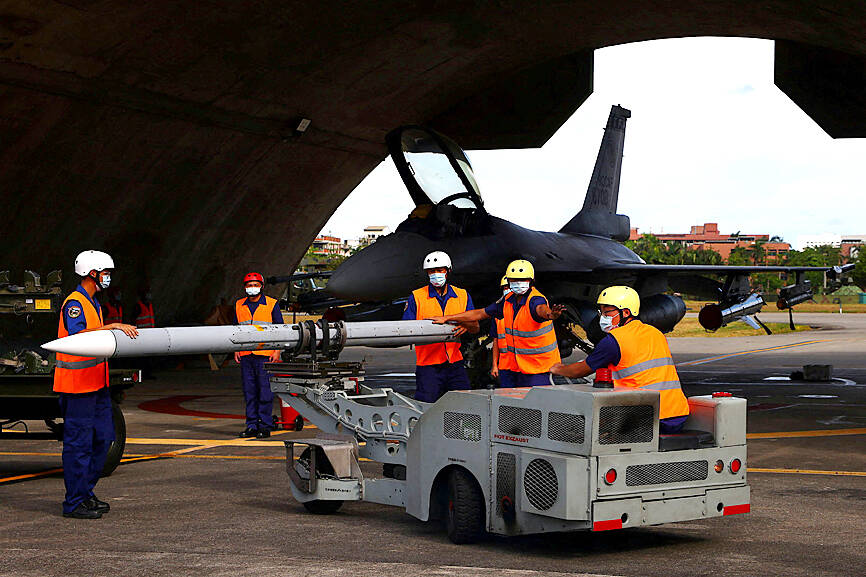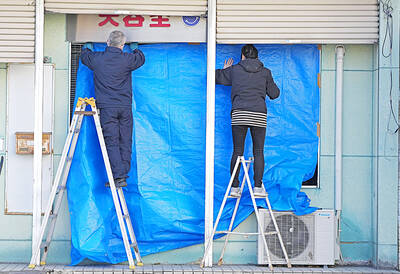The US’ announcement of an arms sales package to Taiwan that includes one of the most advanced missiles in service on US warplanes underlines Washington’s trust in Taipei, a military expert said.
The US Defense Security Cooperation Agency on Wednesday announced a US$619 million package that includes 100 AGM-88B high-speed anti-radiation missiles (HARM), 23 HARM training missiles, 200 AIM-120C-8 advanced medium-range air-to-air missiles (AMRAAM), four AIM-120C-8 AMRAAM guidance systems and 26 LAU-129 multipurpose launchers for F-16 jets.
If approved by the US Congress, the package would mark the first time the US has sold Taiwan the AIM-120C-8 missiles, which are also fielded on advanced US jets including the F/A-18, F-22 and F-35.

Photo: Ann Wang, Reuters
Institute of National Defense and Security Research fellow Su Tzu-yun (蘇紫雲) said the package has political significance in that the AIM-120C-8 is deployed on some of the US’ most advanced aircraft.
This demonstrates the deepening bilateral ties between the nations, and the trust the US has in Taiwan, he said.
The AIM-120C-8 missile — which features a two-way data link and improved navigation using a GPS-enhanced inertial measurement unit — is often deployed on planes in combination with AIM-9 Sidewinder missiles for short to mid-range combat. It is also used by Japan’s air force.
Su said the missile features a greatly increased range of 160km — about 1.5 times that of the previous AIM-120C-7 missile.
Its expanded no-escape envelope and high-angle off-boresight capability mean that enemy aircraft within firing range are less likely to escape, he said.
While a pilot traditionally has to lock on to the tail of an enemy aircraft using a targeting system before initiating a strike, the off-boresight launch capability allows pilots to fire the missiles at extreme angles, he said.
This capability, coupled with a helmet-mounted cueing system, means that pilots would no longer need a clear line of sight on a target, and would be able to fire a missile at an enemy aircraft flanking them just by looking over their shoulder, he said.
Taiwan first acquired 50 AGM-88B missiles from the US during former US president Donald Trump’s administration, he said.
With the addition of the proposed 100 AGM-88B missiles, it would bolster the air force’s ability to target Chinese People’s Liberation Army (PLA) coastal radar stations, communications stations and marine radars, he said.
Although identified in the announcement as simply AGM-88B, it is widely believed that the missiles being proposed for sale are upgraded units from the 2018 HARM control section modification program that reportedly have an increased range of 180km.
Chieh Chung (揭仲), an associate research fellow with the Chinese Nationalist Party (KMT) think tank National Policy Foundation, said that the Ministry of National Defense “took a step in the right direction” by seeking to purchase the missiles, as it would expand Taiwan’s arsenal and be an effective deterrent against PLA warships and aircraft.
The AGM-88B missile would allow the air force to target the radar systems on PLA ships during war, potentially forcing them to retreat, he said.
They could also be deployed against radar stations along China’s southeastern coast, he added.
If the air force can suppress enemy fire, creating a window for a counterstrike, Indigenous Defense Fighters carrying domestically developed Wan Chien air-to-ground missiles could deter PLA forces from deploying missiles against Taiwanese aircraft, he said.

Taiwanese were praised for their composure after a video filmed by Taiwanese tourists capturing the moment a magnitude 7.5 earthquake struck Japan’s Aomori Prefecture went viral on social media. The video shows a hotel room shaking violently amid Monday’s quake, with objects falling to the ground. Two Taiwanese began filming with their mobile phones, while two others held the sides of a TV to prevent it from falling. When the shaking stopped, the pair calmly took down the TV and laid it flat on a tatami mat, the video shows. The video also captured the group talking about the safety of their companions bathing

US climber Alex Honnold is to attempt to scale Taipei 101 without a rope and harness in a live Netflix special on Jan. 24, the streaming platform announced on Wednesday. Accounting for the time difference, the two-hour broadcast of Honnold’s climb, called Skyscraper Live, is to air on Jan. 23 in the US, Netflix said in a statement. Honnold, 40, was the first person ever to free solo climb the 900m El Capitan rock formation in Yosemite National Park — a feat that was recorded and later made into the 2018 documentary film Free Solo. Netflix previewed Skyscraper Live in October, after videos

Starting on Jan. 1, YouBike riders must have insurance to use the service, and a six-month trial of NT$5 coupons under certain conditions would be implemented to balance bike shortages, a joint statement from transportation departments across Taipei, New Taipei City and Taoyuan announced yesterday. The rental bike system operator said that coupons would be offered to riders to rent bikes from full stations, for riders who take out an electric-assisted bike from a full station, and for riders who return a bike to an empty station. All riders with YouBike accounts are automatically eligible for the program, and each membership account

A classified Pentagon-produced, multiyear assessment — the Overmatch brief — highlighted unreported Chinese capabilities to destroy US military assets and identified US supply chain choke points, painting a disturbing picture of waning US military might, a New York Times editorial published on Monday said. US Secretary of Defense Pete Hegseth’s comments in November last year that “we lose every time” in Pentagon-conducted war games pitting the US against China further highlighted the uncertainty about the US’ capability to intervene in the event of a Chinese invasion of Taiwan. “It shows the Pentagon’s overreliance on expensive, vulnerable weapons as adversaries field cheap, technologically